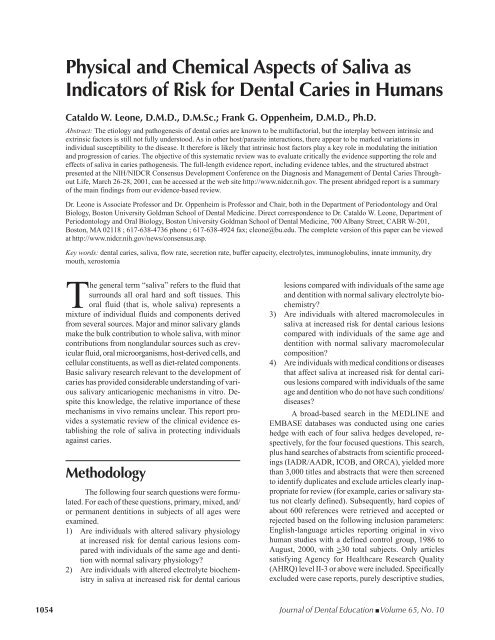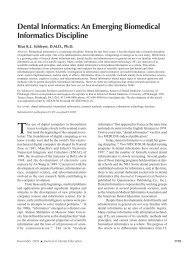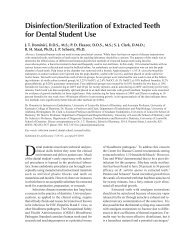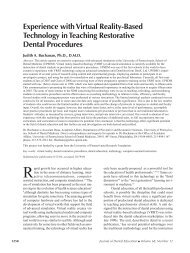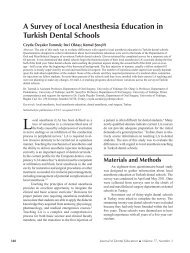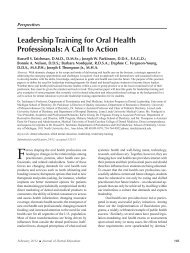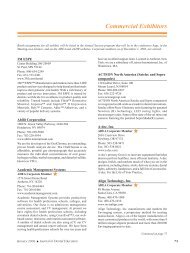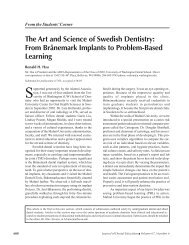Physical and chemical aspects of saliva as indicat... - ResearchGate
Physical and chemical aspects of saliva as indicat... - ResearchGate
Physical and chemical aspects of saliva as indicat... - ResearchGate
You also want an ePaper? Increase the reach of your titles
YUMPU automatically turns print PDFs into web optimized ePapers that Google loves.
<strong>Physical</strong> <strong>and</strong> Chemical Aspects <strong>of</strong> Saliva <strong>as</strong><br />
Indicators <strong>of</strong> Risk for Dental Caries in Humans<br />
Cataldo W. Leone, D.M.D., D.M.Sc.; Frank G. Oppenheim, D.M.D., Ph.D.<br />
Abstract: The etiology <strong>and</strong> pathogenesis <strong>of</strong> dental caries are known to be multifactorial, but the interplay between intrinsic <strong>and</strong><br />
extrinsic factors is still not fully understood. As in other host/par<strong>as</strong>ite interactions, there appear to be marked variations in<br />
individual susceptibility to the dise<strong>as</strong>e. It therefore is likely that intrinsic host factors play a key role in modulating the initiation<br />
<strong>and</strong> progression <strong>of</strong> caries. The objective <strong>of</strong> this systematic review w<strong>as</strong> to evaluate critically the evidence supporting the role <strong>and</strong><br />
effects <strong>of</strong> <strong>saliva</strong> in caries pathogenesis. The full-length evidence report, including evidence tables, <strong>and</strong> the structured abstract<br />
presented at the NIH/NIDCR Consensus Development Conference on the Diagnosis <strong>and</strong> Management <strong>of</strong> Dental Caries Throughout<br />
Life, March 26-28, 2001, can be accessed at the web site http://www.nidcr.nih.gov. The present abridged report is a summary<br />
<strong>of</strong> the main findings from our evidence-b<strong>as</strong>ed review.<br />
Dr. Leone is Associate Pr<strong>of</strong>essor <strong>and</strong> Dr. Oppenheim is Pr<strong>of</strong>essor <strong>and</strong> Chair, both in the Department <strong>of</strong> Periodontology <strong>and</strong> Oral<br />
Biology, Boston University Goldman School <strong>of</strong> Dental Medicine. Direct correspondence to Dr. Cataldo W. Leone, Department <strong>of</strong><br />
Periodontology <strong>and</strong> Oral Biology, Boston University Goldman School <strong>of</strong> Dental Medicine, 700 Albany Street, CABR W-201,<br />
Boston, MA 02118 ; 617-638-4736 phone ; 617-638-4924 fax; cleone@bu.edu. The complete version <strong>of</strong> this paper can be viewed<br />
at http://www.nidcr.nih.gov/news/consensus.<strong>as</strong>p.<br />
Key words: dental caries, <strong>saliva</strong>, flow rate, secretion rate, buffer capacity, electrolytes, immunoglobulins, innate immunity, dry<br />
mouth, xerostomia<br />
The general term “<strong>saliva</strong>” refers to the fluid that<br />
surrounds all oral hard <strong>and</strong> s<strong>of</strong>t tissues. This<br />
oral fluid (that is, whole <strong>saliva</strong>) represents a<br />
mixture <strong>of</strong> individual fluids <strong>and</strong> components derived<br />
from several sources. Major <strong>and</strong> minor <strong>saliva</strong>ry gl<strong>and</strong>s<br />
make the bulk contribution to whole <strong>saliva</strong>, with minor<br />
contributions from nongl<strong>and</strong>ular sources such <strong>as</strong> crevicular<br />
fluid, oral microorganisms, host-derived cells, <strong>and</strong><br />
cellular constituents, <strong>as</strong> well <strong>as</strong> diet-related components.<br />
B<strong>as</strong>ic <strong>saliva</strong>ry research relevant to the development <strong>of</strong><br />
caries h<strong>as</strong> provided considerable underst<strong>and</strong>ing <strong>of</strong> various<br />
<strong>saliva</strong>ry anticariogenic mechanisms in vitro. Despite<br />
this knowledge, the relative importance <strong>of</strong> these<br />
mechanisms in vivo remains unclear. This report provides<br />
a systematic review <strong>of</strong> the clinical evidence establishing<br />
the role <strong>of</strong> <strong>saliva</strong> in protecting individuals<br />
against caries.<br />
Methodology<br />
The following four search questions were formulated.<br />
For each <strong>of</strong> these questions, primary, mixed, <strong>and</strong>/<br />
or permanent dentitions in subjects <strong>of</strong> all ages were<br />
examined.<br />
1) Are individuals with altered <strong>saliva</strong>ry physiology<br />
at incre<strong>as</strong>ed risk for dental carious lesions compared<br />
with individuals <strong>of</strong> the same age <strong>and</strong> dentition<br />
with normal <strong>saliva</strong>ry physiology?<br />
2) Are individuals with altered electrolyte biochemistry<br />
in <strong>saliva</strong> at incre<strong>as</strong>ed risk for dental carious<br />
lesions compared with individuals <strong>of</strong> the same age<br />
<strong>and</strong> dentition with normal <strong>saliva</strong>ry electrolyte biochemistry?<br />
3) Are individuals with altered macromolecules in<br />
<strong>saliva</strong> at incre<strong>as</strong>ed risk for dental carious lesions<br />
compared with individuals <strong>of</strong> the same age <strong>and</strong><br />
dentition with normal <strong>saliva</strong>ry macromolecular<br />
composition?<br />
4) Are individuals with medical conditions or dise<strong>as</strong>es<br />
that affect <strong>saliva</strong> at incre<strong>as</strong>ed risk for dental carious<br />
lesions compared with individuals <strong>of</strong> the same<br />
age <strong>and</strong> dentition who do not have such conditions/<br />
dise<strong>as</strong>es?<br />
A broad-b<strong>as</strong>ed search in the MEDLINE <strong>and</strong><br />
EMBASE datab<strong>as</strong>es w<strong>as</strong> conducted using one caries<br />
hedge with each <strong>of</strong> four <strong>saliva</strong> hedges developed, respectively,<br />
for the four focused questions. This search,<br />
plus h<strong>and</strong> searches <strong>of</strong> abstracts from scientific proceedings<br />
(IADR/AADR, ICOB, <strong>and</strong> ORCA), yielded more<br />
than 3,000 titles <strong>and</strong> abstracts that were then screened<br />
to identify duplicates <strong>and</strong> exclude articles clearly inappropriate<br />
for review (for example, caries or <strong>saliva</strong>ry status<br />
not clearly defined). Subsequently, hard copies <strong>of</strong><br />
about 600 references were retrieved <strong>and</strong> accepted or<br />
rejected b<strong>as</strong>ed on the following inclusion parameters:<br />
English-language articles reporting original in vivo<br />
human studies with a defined control group, 1986 to<br />
August, 2000, with >30 total subjects. Only articles<br />
satisfying Agency for Healthcare Research Quality<br />
(AHRQ) level II-3 or above were included. Specifically<br />
excluded were c<strong>as</strong>e reports, purely descriptive studies,<br />
1054 Journal <strong>of</strong> Dental Education ■ Volume 65, No. 10
<strong>and</strong> articles or portions <strong>of</strong> articles that dealt with <strong>saliva</strong>ry<br />
microbiology, fluoride treatments, food <strong>and</strong> nutrition<br />
factors, tooth-adsorbed <strong>saliva</strong>ry components (that<br />
is, acquired pellicle), pooled <strong>saliva</strong> samples, or in situ<br />
experimental designs.<br />
A data extraction form w<strong>as</strong> developed <strong>and</strong> used<br />
for initial calibration <strong>of</strong> the abstractors. Once a sufficient<br />
level <strong>of</strong> agreement w<strong>as</strong> attained, data from the<br />
articles were entered directly into the evidence table.<br />
Two persons independently abstracted data from each<br />
article, <strong>and</strong> disagreements about articles were resolved<br />
by discussion. Data were synthesized descriptively for<br />
each included article according to five topic are<strong>as</strong>: 1)<br />
general description; 2) experimental design characteristics;<br />
3) caries status <strong>as</strong>sessments; 4) <strong>saliva</strong> status <strong>as</strong>sessments;<br />
<strong>and</strong> 5) clinical evidence for the presence or<br />
absence <strong>of</strong> a protective effect <strong>of</strong> <strong>saliva</strong> against caries.<br />
We focused on both quantitative <strong>and</strong> qualitative <strong><strong>as</strong>pects</strong><br />
<strong>of</strong> <strong>saliva</strong>, such <strong>as</strong> flow rate, buffer capacity, electrolytes,<br />
<strong>and</strong> the various constituents <strong>of</strong> the immune <strong>and</strong><br />
nonimmune defense systems <strong>as</strong> well <strong>as</strong> medical conditions<br />
known to affect <strong>saliva</strong>ry physiology. Data from<br />
the studies were not further analyzed quantitatively, <strong>and</strong><br />
no meta-analysis w<strong>as</strong> performed.<br />
Principal Results<br />
General Description <strong>and</strong> Quality<br />
Assessment <strong>of</strong> the Included Studies<br />
A total <strong>of</strong> ninety-six references are included in<br />
Evidence Tables 1A-C, which can be viewed at the following<br />
web site: http://www.nidcr.nih.gov/news/<br />
consensus.<strong>as</strong>p. The studies evaluated individuals from<br />
twenty-five different countries, primarily Sweden (24<br />
percent), Finl<strong>and</strong> (18 percent), <strong>and</strong> the United States<br />
(14 percent), <strong>and</strong> comprised a mixture <strong>of</strong> medically<br />
healthy <strong>and</strong> compromised subjects. The designs <strong>of</strong> included<br />
studies had the following distribution: crosssectional<br />
c<strong>as</strong>e-control (67 percent), longitudinal cohort<br />
(3 percent), <strong>and</strong> multiple cross-sectional descriptive<br />
samplings (30 percent). Although all studies had a minimum<br />
<strong>of</strong> ⊕30 subjects total, half <strong>of</strong> the studies had only<br />
ten to thirty subjects divided into one to four groups,<br />
which conferred relatively low statistical power. Since<br />
only two <strong>of</strong> the included studies analyzed self-reported<br />
oral dryness, concern about any lack <strong>of</strong> correlation between<br />
subjective symptoms <strong>and</strong> clinical me<strong>as</strong>urements<br />
w<strong>as</strong> minimal. To the extent discernible, publication bi<strong>as</strong><br />
did not appear to be an important factor in this review.<br />
The primary outcome variable for caries w<strong>as</strong> the<br />
DMFT/S score, but considerable heterogeneity w<strong>as</strong><br />
found due to the lack <strong>of</strong> a st<strong>and</strong>ard definition <strong>of</strong> caries<br />
activity versus caries inactivity. Similarly, there w<strong>as</strong> only<br />
partial uniformity in what w<strong>as</strong> defined <strong>as</strong> high or low<br />
<strong>saliva</strong>ry flow rate <strong>and</strong> buffer capacity. Intra- <strong>and</strong><br />
intersubject variations in <strong>saliva</strong>ry parameters complicated<br />
the analyses, <strong>and</strong> there w<strong>as</strong> a lack <strong>of</strong> st<strong>and</strong>ardized<br />
methodology to me<strong>as</strong>ure physiological <strong>and</strong> bio<strong>chemical</strong><br />
parameters <strong>of</strong> <strong>saliva</strong> in relation to dise<strong>as</strong>e<br />
status <strong>and</strong> progression.<br />
Bivariate <strong>and</strong> multivariate statistical analyses<br />
were used in 72 percent <strong>and</strong> 28 percent <strong>of</strong> the studies,<br />
respectively. Interestingly, significant relationships<br />
found in bivariate tests were <strong>of</strong>ten not demonstrated in<br />
the multivariate models. Good evidence for protective<br />
effects <strong>of</strong> <strong>saliva</strong> against caries w<strong>as</strong> found in twenty-one<br />
studies, weak or equivocal evidence in twenty-five studies,<br />
<strong>and</strong> no evidence in fifty studies. It is important to<br />
point out, however, that negative results complicate any<br />
critical review because <strong>of</strong> uncertainty about whether<br />
the lack <strong>of</strong> a demonstrated <strong>as</strong>sociation results from its<br />
true absence or from methodological factors that may<br />
have precluded its discovery.<br />
The majority <strong>of</strong> the studies examined the relationship<br />
<strong>of</strong> stimulated <strong>and</strong>/or unstimulated parotid <strong>and</strong><br />
whole <strong>saliva</strong> to caries on the crowns <strong>of</strong> permanent teeth.<br />
It appears that neither the <strong>saliva</strong>ry stimulation status<br />
nor the method <strong>of</strong> <strong>saliva</strong>ry stimulation (that is, m<strong>as</strong>ticatory<br />
or gustatory) is important in caries risk. There is<br />
insufficient evidence to establish any caries risk related<br />
to differences between whole <strong>saliva</strong> <strong>and</strong> pure secretions<br />
from parotid, subm<strong>and</strong>ibular/sublingual, or minor <strong>saliva</strong>ry<br />
gl<strong>and</strong>s. There is also insufficient evidence to establish<br />
that the risk for caries related to various <strong>saliva</strong>ry<br />
parameters is different for primary vs. permanent<br />
teeth, crown vs. root surfaces, or different <strong><strong>as</strong>pects</strong> <strong>of</strong><br />
crown surfaces.<br />
Evidence for the Incre<strong>as</strong>ed Risk <strong>of</strong><br />
Caries Associated with Salivary<br />
Factors<br />
Salivary flow rate. On the b<strong>as</strong>is <strong>of</strong> twenty-one<br />
studies, chronically low <strong>saliva</strong>ry flow rate (for example<br />
<strong>and</strong> good specificity (⊕0.80). 1-21 It is not surprising,<br />
therefore, that little or no predictive value w<strong>as</strong> observed<br />
for individuals with normal <strong>saliva</strong>ry flow rates. There<br />
were also thirty-four studies that evaluated <strong>saliva</strong>ry flow<br />
rate <strong>and</strong> caries that did not demonstrate an inverse relationship<br />
between the two. 22-55 A number <strong>of</strong> confounding<br />
experimental factors accounted for this negative<br />
result in these latter studies. In particular, whenever differences<br />
in dise<strong>as</strong>e severity were minimal among<br />
groups, then it w<strong>as</strong> very difficult to establish any effect<br />
due to <strong>saliva</strong>ry flow. 34-37,39,43,51,53-55<br />
Salivary buffer capacity <strong>and</strong> ph. Eleven studies<br />
showed a correlation between low <strong>saliva</strong>ry buffer<br />
capacity <strong>and</strong> caries. 4-7,9,15,19,25,38,56,57 As with low flow rate,<br />
poor buffering capacity exhibited poor sensitivity<br />
(≤0.20) <strong>and</strong> good specificity (⊕0.80). The evidence<br />
between poor buffering capacity <strong>and</strong> caries is weaker<br />
than that for low <strong>saliva</strong>ry flow. It is interesting to note,<br />
however, that diminished buffering capacity w<strong>as</strong> not<br />
<strong>as</strong>sociated with <strong>saliva</strong> from individuals who suffered<br />
from flow-reducing gl<strong>and</strong>ular pathologies. When <strong>saliva</strong>ry<br />
pH w<strong>as</strong> evaluated independent <strong>of</strong> buffer capacity,<br />
it w<strong>as</strong> found to be a relatively poor <strong>indicat</strong>or <strong>of</strong> caries<br />
risk. Of the forty studies examining <strong>saliva</strong>ry buffer capacity<br />
<strong>and</strong>/or pH, only three showed a correlation between<br />
low <strong>saliva</strong>ry pH (for example, pH
dence that other electrolytes have any role in establishing<br />
an incre<strong>as</strong>ed risk for caries. 10,12,24,45,46,69 There is also<br />
little to no evidence that <strong>saliva</strong>ry small molecules have<br />
any role in establishing an incre<strong>as</strong>ed risk for caries.<br />
12,16,24,30,45,46,50,69,70,71,72 Interpretation <strong>of</strong> this information<br />
is complicated, however, by the wide range <strong>of</strong> reported<br />
me<strong>as</strong>urements for these components in <strong>saliva</strong>.<br />
Salivary immunoglobulins. Twenty-two studies<br />
examined the relation between <strong>saliva</strong>ry immunoglobulins<br />
<strong>and</strong> caries status. 12,16,29,30,45,46,50,73-87 The levels <strong>of</strong> specific<br />
sIgA showed a modest inverse relationship with<br />
caries risk, <strong>and</strong> the literature is nearly equally divided<br />
for <strong>and</strong> against an anticaries role <strong>of</strong> specific sIgA. Seven<br />
studies reported an inverse relationship between specific<br />
sIgA antibodies in <strong>saliva</strong> (for example, anti-S.<br />
mutans sIgA) <strong>and</strong> caries status, 74,79,81-85 while two studies<br />
reported that caries w<strong>as</strong> related to incre<strong>as</strong>ed levels <strong>of</strong><br />
specific sIgA 80,86 <strong>and</strong> five studies reported no relationship<br />
between specific sIgA immunoglobulins <strong>and</strong> caries.<br />
16,29,30,77,87 With one exception, these reports examined<br />
subjects who were healthy or had medical<br />
conditions not directly related to immunoglobulin deficiency.<br />
30 The levels <strong>of</strong> total sIgA, in contr<strong>as</strong>t to specific<br />
sIgA, were found not to be good risk <strong>indicat</strong>ors.<br />
Although IgG <strong>and</strong> IgM may be compensatory in sIgA<br />
deficient subjects, there is insufficient evidence to establish<br />
a role for these immunoglobulins in caries risk.<br />
Salivary innate non-immunoglobulin factors.<br />
Fourteen studies examined the relationship between<br />
caries <strong>and</strong> one or more <strong>of</strong> the following <strong>saliva</strong>ry factors:<br />
total protein, acidic or b<strong>as</strong>ic proline-rich proteins<br />
(PRPs), statherins, histatins, peroxid<strong>as</strong>e/<br />
myeloperoxid<strong>as</strong>e, lysozyme, lact<strong>of</strong>errin, amyl<strong>as</strong>e, sucr<strong>as</strong>e<br />
activity, <strong>saliva</strong>ry glycoconjugates,<br />
<strong>and</strong> bacteria-aggregating glycoproteins<br />
(BAGPs). 10,12,24,29,30,40,45,46,50,58,69,83,88,89 Virtually all these<br />
studies found no relationship with caries status.<br />
Sjögren’s syndrome <strong>and</strong> <strong>as</strong>sociated conditions.<br />
Three studies evaluated both primary (pSS) <strong>and</strong> secondary<br />
(sSS) forms <strong>of</strong> Sjögren’s dise<strong>as</strong>e, 1,8,90 <strong>and</strong> two<br />
studies evaluated subjects having only pSS. 10,11 Both<br />
pSS <strong>and</strong> sSS were found to be unequivocally <strong>as</strong>sociated<br />
with incre<strong>as</strong>ed caries risk, which w<strong>as</strong> exclusively<br />
due to the pathologically decre<strong>as</strong>ed flow rate observed<br />
in Sjögren’s patients. Neither pSS nor sSS subjects had<br />
any discernible alterations in mean <strong>saliva</strong>ry pH or buffer<br />
capacity, <strong>and</strong> these were not <strong>as</strong>sociated with caries risk<br />
in the studies. Scleroderma is a connective tissue disorder<br />
<strong>as</strong>sociated with sSS, <strong>and</strong> one additional study<br />
found a relationship between scleroderma-related xerostomia<br />
<strong>and</strong> caries prevalence. 91<br />
Radiation, chemotherapy, <strong>and</strong> surgery. Five<br />
studies examined subjects who had received only chemotherapy<br />
without any radiation to the jaws, 34,43,58,60,75<br />
<strong>and</strong> two studies examined subjects who had received a<br />
combination <strong>of</strong> chemotherapy <strong>and</strong> total body irradiation<br />
(that is, bone marrow transplant patients). 23,37 No<br />
evidence w<strong>as</strong> found for an <strong>as</strong>sociation between caries<br />
<strong>and</strong> chemotherapy or total body irradiation. With respect<br />
to local radiation damage <strong>of</strong> the head <strong>and</strong> neck<br />
area, the literature contains sparse evidence b<strong>as</strong>ed on<br />
controlled clinical studies having adequate sample size;<br />
much stronger <strong>as</strong>sociations come from descriptive studies<br />
<strong>and</strong> individual c<strong>as</strong>e reports, which were excluded<br />
here. One study reported equivocal findings on the effects<br />
<strong>of</strong> surgical retropositioning <strong>of</strong> sublingual <strong>saliva</strong>ry<br />
ducts (sialodochopl<strong>as</strong>ty), 62 <strong>and</strong> no studies examined surgery<br />
to the <strong>saliva</strong>ry gl<strong>and</strong>s per se.<br />
Use <strong>of</strong> medications having xerostomic side effects.<br />
Although somewhat limited, the evidence reported<br />
here continues to support the belief that certain medications<br />
that have xerostomic side effects may lead to an<br />
incre<strong>as</strong>ed risk <strong>of</strong> caries. 12,13,92,93 This risk results from<br />
chronically lowered <strong>saliva</strong>ry flow rate rather than other<br />
alterations in <strong>saliva</strong>, for example, poor buffering capacity.<br />
It is important to note that none <strong>of</strong> the studies<br />
me<strong>as</strong>ured the effect <strong>of</strong> discontinuing medication on<br />
<strong>saliva</strong>ry output, so that these findings could be inaccurate<br />
regarding the “incre<strong>as</strong>ed risk” for dental caries.<br />
Other conditions. A number <strong>of</strong> articles attempting<br />
to correlate caries with <strong>saliva</strong>ry disturbances in several<br />
other conditions were also found. These included<br />
both insulin- <strong>and</strong> noninsulin-dependent diabetes,<br />
35,39,51,52,54,94 anorexia <strong>and</strong> bulimia, 9,17,53,63 chronic<br />
malnutrition, 7 Crohn’s dise<strong>as</strong>e, 50 cleft lip <strong>and</strong> cleft palate,<br />
2 various heart conditions, 32,35,76 chronic renal failure,<br />
27 common variable immunodeficiency, 30<br />
<strong>as</strong>thma, 12,31,69,93 Down’s syndrome <strong>and</strong> non-Down’s mental<br />
retardation, 95,96 spinal cord injury, 14 <strong>and</strong> thal<strong>as</strong>semia<br />
major. 46 None <strong>of</strong> these articles provided convincing evi-<br />
Table 2. Summary <strong>of</strong> the evidence according to the strength <strong>of</strong> <strong>as</strong>sociation between <strong>saliva</strong>ry characteristics <strong>and</strong><br />
caries risk<br />
Strong Association Weak-to-Moderate No Association<br />
with Caries Risk Association with Caries Risk with Caries Risk<br />
Flow Rate Buffering Capacity; Calcium/Phosphate; pH (static me<strong>as</strong>urement); Glucose Clearance<br />
Specific sIgA Immunoglobulin<br />
Rate/Concentration; Other Electrolytes & Small<br />
Organic Molecules; Total sIgA; IgG, IgM, Innate<br />
Immunity Factors<br />
October 2001 ■ Journal <strong>of</strong> Dental Education 1057
dence linking caries with <strong>saliva</strong>ry dysfunction in any<br />
<strong>of</strong> these conditions.<br />
Discussion<br />
Dental caries remains a widely prevalent bacterial<br />
infection despite tremendous advances in prevention<br />
<strong>and</strong> treatment, <strong>and</strong> continues to comprise a significant<br />
portion <strong>of</strong> total U.S. expenditures on health care.<br />
Why caries continues to be a major public health problem<br />
remains an unanswered question, but insight may<br />
be gained through <strong>as</strong>sessment <strong>of</strong> the risk factors <strong>as</strong>sociated<br />
with the dise<strong>as</strong>e. This report h<strong>as</strong> evaluated the<br />
evidence implicating <strong>saliva</strong>ry parameters <strong>as</strong> probable<br />
risk factors.<br />
Saliva is a complex body fluid that provides a<br />
general protective function for exposed oral hard tissues.<br />
Several medical conditions, such <strong>as</strong> Sjögren’s syndrome,<br />
therapeutic radiation to the head <strong>and</strong> neck, <strong>and</strong><br />
pharmacological agents with xerostomic side effects,<br />
lower <strong>saliva</strong>ry flow rate to pathological levels <strong>and</strong> dramatically<br />
elevate the patient’s risk <strong>of</strong> caries. However,<br />
there is no evidence that physiologically low <strong>saliva</strong>ry<br />
flow rates produce a similar outcome. This may reflect<br />
the incre<strong>as</strong>ed importance <strong>of</strong> other factors such <strong>as</strong> dietary<br />
<strong>and</strong> oral hygiene habits <strong>as</strong> well <strong>as</strong> microbial load<br />
in determining caries susceptibility in subjects with<br />
normal but low <strong>saliva</strong>ry flow. The evidence therefore<br />
<strong>indicat</strong>es that normal <strong>saliva</strong>ry flow rate is strongly protective<br />
against caries, <strong>and</strong> clinicians should identify<br />
individuals with reduced <strong>saliva</strong>ry output to modify their<br />
treatment <strong>and</strong> prevention programs in ways that diminish<br />
the risk <strong>of</strong> caries.<br />
On the other h<strong>and</strong>, there are several confounding<br />
<strong><strong>as</strong>pects</strong> <strong>as</strong>sociated with studies attempting to correlate<br />
other <strong>saliva</strong>ry parameters <strong>and</strong> caries development. Caries<br />
is a multifactorial dise<strong>as</strong>e, <strong>of</strong> which <strong>saliva</strong>ry parameters<br />
represent only a fraction <strong>of</strong> all contributing factors.<br />
Furthermore, <strong>saliva</strong>ry compositions show<br />
considerable intersubject variations <strong>and</strong>, unlike the compositions<br />
<strong>of</strong> other body fluids, are dependent on flow<br />
rate, which in turn is regulated almost exclusively by<br />
the autonomic nervous system. In addition, the likelihood<br />
that a specific <strong>saliva</strong>ry parameter can be identified<br />
<strong>as</strong> the causative agent for caries development in<br />
Figure 1.<br />
Schematic summary <strong>of</strong> the biological considerations in interpreting the clinical evidence <strong>of</strong> the relationship between <strong>saliva</strong> <strong>and</strong><br />
caries risk. There are several levels <strong>of</strong> redundancies in the <strong>saliva</strong>ry system that likely have evolved over time to ensure maximal<br />
protective effects to the organism. For example, there are three paired major <strong>saliva</strong>ry gl<strong>and</strong>s all <strong>of</strong> which secrete important<br />
protective factors. Mineral homeost<strong>as</strong>is is maintained by a number <strong>of</strong> proteins, such <strong>as</strong> the proline rich proteins, statherin,<br />
cystatin, <strong>and</strong> histatin 1. Antimicrobial activity is provided by sIgA <strong>and</strong> several factors <strong>of</strong> the innate immune system, including<br />
peroxid<strong>as</strong>e, lysozyme, lact<strong>of</strong>errin, <strong>and</strong> the histatins. Clearly, this redundancy complicates identification <strong>of</strong> any one specific<br />
<strong>saliva</strong>ry quality to be strongly <strong>as</strong>sociated with anticaries function. Rather, it appears that these myriad protective mechanisms<br />
work in combination <strong>and</strong> provide needed “backup” when necessary.<br />
1058 Journal <strong>of</strong> Dental Education ■ Volume 65, No. 10
vivo is very small. This consideration is b<strong>as</strong>ed on the<br />
fact that the <strong>saliva</strong>ry system exhibits several levels <strong>of</strong><br />
redundancies (Figure 1). At the morphological level<br />
there is redundancy by the presence <strong>of</strong> more than one<br />
major <strong>saliva</strong>ry gl<strong>and</strong> <strong>and</strong> that the major gl<strong>and</strong>s occur in<br />
pairs. Some <strong>saliva</strong>ry constituents are specific for one<br />
type <strong>of</strong> gl<strong>and</strong>; others occur in more than one type <strong>of</strong><br />
gl<strong>and</strong>ular secretion. On the molecular level there is functional<br />
redundancy since different <strong>saliva</strong>ry proteins can<br />
display similar functional characteristics. Also there is<br />
molecular redundancy with respect to individual <strong>saliva</strong>ry<br />
proteins, which h<strong>as</strong> an evolutionary b<strong>as</strong>is. Most<br />
<strong>saliva</strong>ry proteins have evolved into families <strong>of</strong> polymorphic<br />
forms. Within each <strong>of</strong> such a protein family,<br />
the individual members differ structurally in minor ways<br />
but exhibit almost the same functional characteristics.<br />
It h<strong>as</strong> become clear that these multiple levels <strong>of</strong> redundancies<br />
in the <strong>saliva</strong>ry system introduce great difficulties<br />
for the identification <strong>of</strong> specific <strong>saliva</strong>ry parameters<br />
<strong>as</strong> dise<strong>as</strong>e risk factors. There is little doubt,<br />
however, that each <strong>of</strong> the <strong>saliva</strong>ry constituents makes a<br />
contribution to the overall <strong>saliva</strong>ry functional capacity.<br />
In conclusion, normal <strong>saliva</strong>ry output, <strong>as</strong> quantified<br />
by flow rate, is an extremely important intrinsic<br />
host factor providing protection against caries, <strong>and</strong> the<br />
evidence demonstrating that pathologically diminished<br />
flow rate is a significant risk factor for caries development<br />
is quite strong (Table 2). Some studies <strong>indicat</strong>e<br />
that <strong>saliva</strong>ry low buffering capacity, low calcium <strong>and</strong><br />
phosphate, <strong>and</strong> low specific sIgA show a less pronounced<br />
link to incre<strong>as</strong>ed caries. No <strong>as</strong>sociation with<br />
caries risk w<strong>as</strong> found for <strong>saliva</strong>ry pH, other electrolytes<br />
or small molecules, total sIgA, IgG, IgM, <strong>and</strong> other<br />
<strong>saliva</strong>ry proteins, including those <strong>of</strong> the innate host defense<br />
system. It is possible that this lack <strong>of</strong> correlation<br />
is due to the multiple levels <strong>of</strong> structure-function redundancies<br />
found in <strong>saliva</strong>.<br />
Acknowledgments<br />
This research w<strong>as</strong> supported in part by NIH/<br />
NIDCR Grants DE05672 <strong>and</strong> DE07268. The authors<br />
express their gratitude to Dr. Ibtisam Al-H<strong>as</strong>himi,<br />
Baylor College <strong>of</strong> Dentistry, for critically reviewing the<br />
evidence report. The following individuals from the<br />
Boston University <strong>saliva</strong>ry research group are also<br />
thanked for their help: Drs. Bianca Flora, Heloisa<br />
Gusman, Peter Ksenyuk, Ji Li, Giacomo Ori, Sean<br />
Rayment, Robert Troxler, Yuan Yao, Aidi Yin, Mr. Joseph<br />
Keen <strong>and</strong> Ms. Kathrin Tschannen. The <strong>as</strong>sistance<br />
<strong>of</strong> Ms. Mary McKeon <strong>of</strong> the Boston University Alumni<br />
Medical Library is also acknowledged. Special appreciation<br />
is given to Ms. Patricia F. Anderson, University<br />
<strong>of</strong> Michigan, for invaluable <strong>as</strong>sistance with the library<br />
searches that made this work possible.<br />
REFERENCES<br />
1. Almstahl A, Kroneld U, Tarkowski A, Wikstrom M. Oral<br />
microbial flora in Sjögren’s syndrome. J Rheumatol<br />
1999;26:110-4.<br />
2. Dahll<strong>of</strong> G, Ussisoo-Jo<strong>and</strong>i R, Ideberg M, Modeer T. Caries,<br />
gingivitis, <strong>and</strong> dental abnormalities in preschool children<br />
with cleft lip <strong>and</strong>/or palate. Cleft Palate J<br />
1989;26:233-7; discussion 237-8.<br />
3. Furh<strong>of</strong>f AK, et al. A multidisciplinary clinical study <strong>of</strong><br />
patients suffering from illness <strong>as</strong>sociated with rele<strong>as</strong>e <strong>of</strong><br />
mercury from dental restorations: medical <strong>and</strong> odontological<br />
<strong><strong>as</strong>pects</strong> [see comments]. Sc<strong>and</strong> J Primary Health<br />
Care 1998;16:247-52.<br />
4. Guivante-Nabet C, Berenholc C, Berdal A. Caries activity<br />
<strong>and</strong> <strong>as</strong>sociated risk factors in elderly hospitalised population—15-months<br />
follow-up in French institutions.<br />
Gerodontol 1999;16:47-58.<br />
5. Holbrook WP. Dental caries <strong>and</strong> cariogenic factors in preschool<br />
urban Icel<strong>and</strong>ic children. Caries Res 1993;27:431-<br />
7.<br />
6. Holbrook WP, de Soet JJ, de Graaff J. Prediction <strong>of</strong> dental<br />
caries in pre-school children. Caries Res 1993;27:424-<br />
30.<br />
7. Johansson I, Saellstrom AK, Rajan BP, Parameswaran A.<br />
Salivary flow <strong>and</strong> dental caries in Indian children suffering<br />
from chronic malnutrition. Caries Res 1992;26:38-<br />
43.<br />
8. Najera MP, al-H<strong>as</strong>himi I, Plemons JM, Rivera-Hidalgo F,<br />
Rees TD, Haghighat N, Wright JM. Prevalence <strong>of</strong> periodontal<br />
dise<strong>as</strong>e in patients with Sjögren’s syndrome. Oral<br />
Surg Oral Med Oral Pathol Oral Radiol Endod<br />
1997;83:453-7.<br />
9. Ohrn R, Enzell K, Angmar-Mansson B. Oral status <strong>of</strong> 81<br />
subjects with eating disorders. Eur J Oral Sci<br />
1999;107:157-63.<br />
10. Pedersen AM, Reibel J, Nordgarden H, Bergem HO,<br />
Jensen JL, Naunt<strong>of</strong>te B. Primary Sjögren’s syndrome:<br />
<strong>saliva</strong>ry gl<strong>and</strong> function <strong>and</strong> clinical oral findings. Oral<br />
Dis 1999;5:128-38.<br />
11. Ravald N, List T. Caries <strong>and</strong> periodontal conditions in<br />
patients with primary Sjögren’s syndrome. Swed Dent J<br />
1998;22:97-103.<br />
12. Ryberg M, Moller C, Ericson T. Saliva composition <strong>and</strong><br />
caries development in <strong>as</strong>thmatic patients treated with beta<br />
2-adrenoceptor agonists: a 4-year follow-up study. Sc<strong>and</strong><br />
J Dent Res 1991;99:212-8.<br />
13. Stiefel DJ, Truelove EL, Menard TW, Anderson VK, Doyle<br />
PE, M<strong>and</strong>el LS. A comparison <strong>of</strong> the oral health <strong>of</strong> persons<br />
with <strong>and</strong> without chronic mental illness in community<br />
settings. Spec Care Dent 1990;10:6-12.<br />
14. Stiefel DJ, Truelove EL, Persson RS, Chin MM, M<strong>and</strong>el<br />
LS. A comparison <strong>of</strong> oral health in spinal cord injury <strong>and</strong><br />
other disability groups. Spec Care Dent 1993;13:229-35.<br />
15. Tukia-Kulmala H, Tenovuo J. Intra- <strong>and</strong> inter-individual<br />
variation in <strong>saliva</strong>ry flow rate, buffer effect, lactobacilli,<br />
October 2001 ■ Journal <strong>of</strong> Dental Education 1059
<strong>and</strong> mutans streptococci among 11- to 12-year-old schoolchildren.<br />
Acta Odont Sc<strong>and</strong> 1993;51:31-7.<br />
16. Kirstila V, Hakkinen P, Jentsch H, Vilja P, Tenovuo J. Longitudinal<br />
analysis <strong>of</strong> the <strong>as</strong>sociation <strong>of</strong> human <strong>saliva</strong>ry<br />
antimicrobial agents with caries increment <strong>and</strong> cariogenic<br />
micro-organisms: a two-year cohort study. J Dent Res<br />
1998;77:73-80.<br />
17. Rytomaa I, Jarvinen V, Kanerva R, Heinonen OP. Bulimia<br />
<strong>and</strong> tooth erosion. Acta Odont Sc<strong>and</strong> 1998;56:36-40.<br />
18. Sundin B, Granath L, Birkhed D. Variation <strong>of</strong> posterior<br />
approximal caries incidence with consumption <strong>of</strong> sweets<br />
with regard to other caries-related factors in 15-18-yearolds.<br />
Community Dent Oral Epidemiol 1992;20:76-80.<br />
19. Vehkalahti M, Nikula-Sarakorpi E, Paunio I. Evaluation<br />
<strong>of</strong> <strong>saliva</strong>ry tests <strong>and</strong> dental status in the prediction <strong>of</strong> caries<br />
increment in caries-susceptible teenagers. Caries Res<br />
1996;30:22-8.<br />
20. Woltgens JH, Gruythuysen RJ, Geraets WG. Relationship<br />
between cariogenic events <strong>and</strong> <strong>saliva</strong>ry tests in boys <strong>and</strong><br />
girls: oral examination. J de Biol Buccale 1992;20:145-<br />
9.<br />
21. Woltgens JH, Gruythuysen RJ, van der Linden LW, Geraets<br />
WG. Cariogenic changes in dental enamel <strong>of</strong> boys <strong>and</strong><br />
girls in relation to <strong>saliva</strong>ry properties. II. Radiological<br />
examination. J de Biol Buccale 1992;20:235-40.<br />
22. Bergman B, Ericson G. Cross-sectional study <strong>of</strong> patients<br />
treated with removable partial dentures with special reference<br />
to the caries situation. Sc<strong>and</strong> J Dent Res<br />
1986;94:436-42.<br />
23. Dahll<strong>of</strong> G, Bagesund M, Ringden O. Impact <strong>of</strong> conditioning<br />
regimens on <strong>saliva</strong>ry function, caries-<strong>as</strong>sociated<br />
microorganisms <strong>and</strong> dental caries in children after bone<br />
marrow transplantation: a 4-year longitudinal study. Bone<br />
Marrow Transplant 1997;20:479-83.<br />
24. Dodds MW, Johnson DA, Mobley CC, Hattaway KM.<br />
Parotid <strong>saliva</strong> protein pr<strong>of</strong>iles in caries-free <strong>and</strong> cariesactive<br />
adults. Oral Surg Oral Med Oral Pathol Oral Radiol<br />
Endod 1997;83:244-51.<br />
25. Faine MP, Allender D, Baab D, Persson R, Lamont RJ.<br />
Dietary <strong>and</strong> <strong>saliva</strong>ry factors <strong>as</strong>sociated with root caries.<br />
Spec Care Dent 1992;12:177-82.<br />
26. Fure S. Five-year incidence <strong>of</strong> caries, <strong>saliva</strong>ry <strong>and</strong> microbial<br />
conditions in 60-, 70- <strong>and</strong> 80-year-old Swedish individuals.<br />
Caries Res 1998;32:166-74.<br />
27. Gavalda C, Bagan J, Scully C, Silvestre F, Milian M,<br />
Jimenez Y. Renal hemodialysis patients: oral, <strong>saliva</strong>ry,<br />
dental <strong>and</strong> periodontal findings in 105 adult c<strong>as</strong>es. Oral<br />
Dis 1999;5:299-302.<br />
28. Hellyer P, Beighton D, Heath R, Lynch E. Clinical <strong>and</strong><br />
microbiological correlates <strong>of</strong> root caries. General Session<br />
<strong>of</strong> the International Association for Dental Research,<br />
1989:Abstract #471.<br />
29. Hocini H, Iscaki S, Bouvet JP, Pillot J. Unexpectedly high<br />
levels <strong>of</strong> some presumably protective secretory immunoglobulin<br />
A antibodies to dental plaque bacteria in <strong>saliva</strong>s<br />
<strong>of</strong> both caries-resistant <strong>and</strong> caries-susceptible subjects.<br />
Infect Immun 1993;61:3597-604.<br />
30. Kirstila V, Tenovuo J, Ruuskanen O, Nikoskelainen J, Irjala<br />
K, Vilja P. Salivary defense factors <strong>and</strong> oral health in patients<br />
with common variable immunodeficiency. J Clin<br />
Immun 1994;14:229-36.<br />
31. Laurikainen K, Kuusisto P. Comparison <strong>of</strong> the oral health<br />
status <strong>and</strong> <strong>saliva</strong>ry flow rate <strong>of</strong> <strong>as</strong>thmatic patients with<br />
those <strong>of</strong> non<strong>as</strong>thmatic adults—results <strong>of</strong> a pilot study.<br />
Allergy 1998;53:316-9.<br />
32. Lundgren M, Emilson CG, Osterberg T, Steen G, Birkhed<br />
D, Steen B. Dental caries <strong>and</strong> related factors in 88- <strong>and</strong><br />
92-year-olds: cross-sectional <strong>and</strong> longitudinal comparisons.<br />
Acta Odont Sc<strong>and</strong> 1997;55:282-91.<br />
33. MacEntee MI, Clark DC, Glick N. Predictors <strong>of</strong> caries in<br />
old age. Gerodontol 1993;10:90-7.<br />
34. Meurman JH, Laine P, Lindqvist C, Teerenhovi L,<br />
Pyrhonen S. Five-year follow-up study <strong>of</strong> <strong>saliva</strong>, mutans<br />
streptococci, lactobacilli <strong>and</strong> ye<strong>as</strong>t counts in lymphoma<br />
patients. Oral Oncol 1997;33:439-43.<br />
35. Narhi TO, Meurman JH, Odont D, Ainamo A, Tilvis R.<br />
Oral health in the elderly with non-insulin-dependent diabetes<br />
mellitus. Spec Care Dent 1996;16:116-22.<br />
36. Narhi TO, Kurki N, Ainamo A. Saliva, <strong>saliva</strong>ry microorganisms,<br />
<strong>and</strong> oral health in the home-dwelling old elderly—a<br />
five-year longitudinal study. J Dent Res<br />
1999;78:1640-6.<br />
37. N<strong>as</strong>man M, Bjork O, Soderhall S, Ringden O, Dahll<strong>of</strong> G.<br />
Disturbances in the oral cavity in pediatric long-term survivors<br />
after different forms <strong>of</strong> antineopl<strong>as</strong>tic therapy.<br />
Pediatr Dent 1994;16:217-23.<br />
38. O’Sullivan EA, Curzon ME. Salivary factors affecting<br />
dental erosion in children. Caries Res 2000;34:82-7.<br />
39. Pohjamo L, Knuuttila M, Tervonen T, Haukipuro K. Caries<br />
prevalence related to the control <strong>of</strong> diabetes. Proc Finn<br />
Dent Soc 1988;84:247-52.<br />
40. Raitio M, Pienihakkinen K, Scheinin A. Multifactorial<br />
modeling for prediction <strong>of</strong> caries increment in adolescents.<br />
Acta Odont Sc<strong>and</strong> 1996;54:118-21.<br />
41. Raitio M, Pienihakkinen K, Scheinin A. Assessment <strong>of</strong><br />
single risk <strong>indicat</strong>ors in relation to caries increment in<br />
adolescents. Acta Odont Sc<strong>and</strong> 1996;54:113-7.<br />
42. Ravald N, Birkhed D, Hamp SE. Root caries susceptibility<br />
in periodontally treated patients: results after 12 years.<br />
J Clin Periodontol 1993;20:124-9.<br />
43. Sepet E, Aytepe Z, Ozerkan AG, et al. Acute lymphobl<strong>as</strong>tic<br />
leukemia: dental health <strong>of</strong> children in maintenance<br />
therapy. J Clin Pediatr Dent 1998;22:257-60.<br />
44. Sgan-Cohen HD, Steinberg D, Zusman SP, Sela MN. Dental<br />
caries <strong>and</strong> its determinants among recent immigrants<br />
from rural Ethiopia. Community Dent Oral Epidemiol<br />
1992;20:338-42.<br />
45. Siamopoulou A, Mavridis AK, V<strong>as</strong>akos S, Benecos P,<br />
Tziouf<strong>as</strong> AG, Andonopoulos AP. Sialochemistry in juvenile<br />
chronic arthritis. Br J Rheumatol 1989;28:383-5.<br />
46. Siamopoulou-Mavridou A, Mavridis A, Galanakis E,<br />
V<strong>as</strong>akos S, Fatourou H, Lapatsanis P. Flow rate <strong>and</strong> chemistry<br />
<strong>of</strong> parotid <strong>saliva</strong> related to dental caries <strong>and</strong> gingivitis<br />
in patients with thal<strong>as</strong>saemia major. Int J Paediatr Dent<br />
1992;2:93-7.<br />
47. Soderholm G, Birkhed D. Caries predicting factors in adult<br />
patients participating in a dental health program. Community<br />
Dent Oral Epidemiol 1988;16:374-7.<br />
48. Sullivan A, Schroder U. Systematic analysis <strong>of</strong> gingival<br />
state <strong>and</strong> <strong>saliva</strong>ry variables <strong>as</strong> predictors <strong>of</strong> caries from 5<br />
to 7 years <strong>of</strong> age. Sc<strong>and</strong>inavian J Dent Res 1989;97:25-<br />
32.<br />
1060 Journal <strong>of</strong> Dental Education ■ Volume 65, No. 10
49. Sullivan A. Correlation between caries incidence <strong>and</strong> secretion<br />
rate/buffer capacity <strong>of</strong> stimulated whole <strong>saliva</strong> in<br />
5-7-year-old children matched for lactobacillus count <strong>and</strong><br />
gingival state. Swedish Dent J 1990;14:131-5.<br />
50. Sundh B, Johansson I, Emilson CG, Nordgren S, Birkhed<br />
D. Salivary antimicrobial proteins in patients with Crohn’s<br />
dise<strong>as</strong>e. Oral Surg Oral Med Oral Pathol 1993;76:564-9.<br />
51. Swanljung O, Meurman JH, Torkko H, S<strong>and</strong>holm L,<br />
Kaprio E, Maenpaa J. Caries <strong>and</strong> <strong>saliva</strong> in 12-18-year-old<br />
diabetics <strong>and</strong> controls. Sc<strong>and</strong>inavian J Dent Res<br />
1992;100:310-3.<br />
52. Tenovuo J, Alanen P, Larjava H, Viikari J, Lehtonen OP.<br />
Oral health <strong>of</strong> patients with insulin-dependent diabetes<br />
mellitus. Sc<strong>and</strong>inavian J Dent Res 1986;94:338-46.<br />
53. Touyz SW, Liew VP, Tseng P, Frisken K, Williams H,<br />
Beumont PJ. Oral <strong>and</strong> dental complications in dieting disorders.<br />
Int J Eat Disord 1993;14:341-7.<br />
54. Twetman S, Aronsson S, Bjorkman S. Mutans streptococci<br />
<strong>and</strong> lactobacilli in <strong>saliva</strong> from children with insulin-dependent<br />
diabetes mellitus. Oral Microbiol Immunol<br />
1989;4:165-8.<br />
55. Younger H, Harrison T, Streckfus C. Relationship among<br />
stimulated whole, gl<strong>and</strong>ular <strong>saliva</strong>ry flow rates, <strong>and</strong> root<br />
caries prevalence in an elderly population: a preliminary<br />
study. Spec Care Dent 1998;18:156-63.<br />
56. Wiktorsson AM, Martinsson T, Zimmerman M. Salivary<br />
levels <strong>of</strong> lactobacilli, buffer capacity <strong>and</strong> <strong>saliva</strong>ry flow<br />
rate related to caries activity among adults in communities<br />
with optimal <strong>and</strong> low water fluoride concentrations.<br />
Swed Dent J 1992;16:231-7.<br />
57. Pienihakkinen K. Caries prediction through combined use<br />
<strong>of</strong> incipient caries lesions, <strong>saliva</strong>ry buffering capacity, lactobacilli<br />
<strong>and</strong> ye<strong>as</strong>ts in Hungary [corrected] [published<br />
erratum appears in Community Dent Oral Epidemiol 1988<br />
Jun;16(3):192]. Community Dent Oral Epidemiol<br />
1987;15:325-8.<br />
58. Pajari U. Effect <strong>of</strong> anti-neopl<strong>as</strong>tic therapy on dental hard<br />
tissues <strong>and</strong> <strong>saliva</strong> in children <strong>and</strong> adolescents: a clinical<br />
<strong>and</strong> experimental study. Proc Finn Dent Society 1988;84<br />
(suppl) 10:1-59.<br />
59. Demers M, Brodeur JM, Mouton C, Simard PL, Trahan<br />
L, Veilleux G. A multivariate model to predict caries increment<br />
in Montreal children aged 5 years. Community<br />
Dent Health 1992;9:273-81.<br />
60. Dens FL, Boute P, Vinckier F, Declerck D. Salivary caries<br />
risk factors in long-term event-free survivors <strong>of</strong> pediatric<br />
malignant dise<strong>as</strong>es. J Clinic Pediatr Dent 1996;20:241-5.<br />
61. Grindefjord M, Dahll<strong>of</strong> G, Modeer T. Caries development<br />
in children from 2.5 to 3.5 years <strong>of</strong> age: a longitudinal<br />
study. Caries Res 1995;29:449-54.<br />
62. Hallett KB, Luc<strong>as</strong> JO, Johnston T, Reddihough DS, Hall<br />
RK. Dental health <strong>of</strong> children with cerebral palsy following<br />
sialodochopl<strong>as</strong>ty. Spec Care Dent 1995;15:234-8.<br />
63. Milosevic A, Slade PD. The orodental status <strong>of</strong> anorexics<br />
<strong>and</strong> bulimics. Br Dent J 1989;167:66-70.<br />
64. Pienihakkinen K, Nemes J, Scheinin A, Banoczy J. Salivary<br />
buffering capacity <strong>and</strong> its relation to caries increment<br />
in children. Proc Finn Dent Society 1987;83:47-54.<br />
65. Zimmer S, Twerskol V, Roulet J-F. Two years validation<br />
<strong>of</strong> caries risk <strong>as</strong>sessment by clinical <strong>and</strong> <strong>saliva</strong>ry parameters.<br />
General Session <strong>of</strong> the IADR, 1997:Abstract #2852.<br />
66. Lowe LG, Cleaton-Jones PE, Smit AM. Oral glucose clearance<br />
in 12-year-old South Africans. J S Afr Dent Assoc<br />
1997;52:65-8.<br />
67. Duggal MS, Chawla HS, Curzon ME. A study <strong>of</strong> the relationship<br />
between trace elements in <strong>saliva</strong> <strong>and</strong> dental caries<br />
in children. Arch Oral Biol 1991;36:881-4.<br />
68. P<strong>and</strong>ey RK, Tripathi A, Ch<strong>and</strong>ra S, P<strong>and</strong>ey A. Relation<br />
<strong>of</strong> <strong>saliva</strong>ry phosphorus <strong>and</strong> alkaline phosphat<strong>as</strong>e to the<br />
incidence <strong>of</strong> dental caries in children. J Pedo 1990;14:144-<br />
6.<br />
69. Len<strong>and</strong>er-Lumikari M, Laurikainen K, Kuusisto P, Vilja<br />
P. Stimulated <strong>saliva</strong>ry flow rate <strong>and</strong> composition in <strong>as</strong>thmatic<br />
<strong>and</strong> non-<strong>as</strong>thmatic adults. Arch Oral Biol<br />
1998;43:151-6.<br />
70. Van Wuyckhuyse BC, et al. Association <strong>of</strong> free arginine<br />
<strong>and</strong> lysine concentrations in human parotid <strong>saliva</strong> with<br />
caries experience [published erratum appears in J Dent<br />
Res 1995;74(7):following 1432]. J Dent Res 1995;74:686-<br />
90.<br />
71. Vranic L, Granic P, Rajic Z. B<strong>as</strong>ic amino acid in the pathogenesis<br />
<strong>of</strong> caries. Acta Stoma Croatica 1991;25:71-6.<br />
72. Coogan MM, Motlekar HB. Salivary <strong>and</strong> plaque acids in<br />
caries active <strong>and</strong> caries free subjects. J Dent Assoc <strong>of</strong> S<br />
Afr 1996;51:823-7.<br />
73. Bhatia S, Chawla HS, Tewari A, Ganguly NK. Naturally<br />
occurring s-IgA <strong>saliva</strong> <strong>of</strong> adults <strong>and</strong> children—correlation<br />
with dental caries activity. J Indian Soc Pedo Prevent<br />
Dent 1986;4:1-7.<br />
74. Camling E, Kohler B. Infection with the bacterium Streptococcus<br />
mutans <strong>and</strong> <strong>saliva</strong>ry IgA antibodies in mothers<br />
<strong>and</strong> their children. Arch Oral Biol 1987;32:817-23.<br />
75. Dens F, Boute P, Vinckier F, Declerck D. Quantitative determination<br />
<strong>of</strong> immunologic components <strong>of</strong> <strong>saliva</strong>ry gl<strong>and</strong><br />
secretion in long-term, event-free pediatric oncology patients.<br />
Oral Surg Oral Med Oral Pathol Oral Radiol Endod<br />
1995;79:701-4.<br />
76. Franco E, Saunders CP, Roberts GJ, Suwanpr<strong>as</strong>it A. Dental<br />
dise<strong>as</strong>e, caries related micr<strong>of</strong>lora <strong>and</strong> <strong>saliva</strong>ry IgA <strong>of</strong><br />
children with severe congenital cardiac dise<strong>as</strong>e: an epidemiological<br />
<strong>and</strong> oral microbial survey. Pediatr Dent<br />
1996;18:228-35.<br />
77. N<strong>as</strong>pitz GM, Nagao AT, Mayer MP, Carneiro-Sampaio<br />
MM. Anti-Streptococcus mutans antibodies in <strong>saliva</strong> <strong>of</strong><br />
children with different degrees <strong>of</strong> dental caries. Pediatr<br />
Allergy Immun 1999;10:143-8.<br />
78. Riviere GR, Papagiannoulis L. Antibodies to indigenous<br />
<strong>and</strong> laboratory strains <strong>of</strong> Streptococcus mutans in <strong>saliva</strong><br />
from children with dental caries <strong>and</strong> from caries-free children.<br />
Pediatr Dent 1987;9:216-20.<br />
79. Rose PT, Gregory RL, Gfell LE, Hughes CV. IgA antibodies<br />
to Streptococcus mutans in caries-resistant <strong>and</strong> -<br />
susceptible children. Pediatr Dent 1994;16:272-5.<br />
80. Park<strong>as</strong>h H, Sharma A, Banerjee U, Sidhu SS, Sundaram KR.<br />
Humoral immune response to mutans streptococci <strong>as</strong>sociated<br />
with dental caries. Nat Med J India 1994;7:263-6.<br />
81. Chia JS, Lin SW, Yang CS, Chen JY. Antigenicity <strong>of</strong> a synthetic<br />
peptide from glucosyltransfer<strong>as</strong>es <strong>of</strong> Streptococcus<br />
mutans in humans. Infect Immun 1997;65:1126-30.<br />
82. Gregory RL, Filler SJ, Michalek SM, McGhee JR. Salivary<br />
immunoglobulin A <strong>and</strong> serum antibodies to Strepto-<br />
October 2001 ■ Journal <strong>of</strong> Dental Education 1061
coccus mutans ribosomal preparations in dental cariesfree<br />
<strong>and</strong> caries-susceptible human subjects. Infect Immun<br />
1986;51:348-51.<br />
83. Gregory RL, Kindle JC, Hobbs LC, Filler SJ, Malmstrom<br />
HS. Function <strong>of</strong> anti-Streptococcus mutans antibodies:<br />
inhibition <strong>of</strong> virulence factors <strong>and</strong> enzyme neutralization.<br />
Oral Microbiol Immun 1990;5:181-8.<br />
84. Gregory RL, Gfell LE, Malmstrom HS. Differences in<br />
secretory IgA <strong>and</strong> serum antibodies to Streptococcus<br />
mutans isolates from caries-resistant <strong>and</strong> caries-susceptible<br />
subjects. Adv Exp Med Biol 1995;371B:1149-52.<br />
85. Rose P, Gregory R, Gfell L, Hughes C. IgA antibodies to<br />
Streptococcus mutans in caries resistant/susceptible children.<br />
General Session <strong>of</strong> the International Association for<br />
Dental Research, 1993:Abstract #1793.<br />
86. Seemann R, Kage A. Antiadhesive molecules in <strong>saliva</strong> <strong>as</strong><br />
risk factors for dental caries. General Session <strong>of</strong> the International<br />
Association for Dental Research, 1997:Abstract<br />
#2292.<br />
87. Gregory RL, Kindle JC, Hobbs LC, Malmstrom HS. Effect<br />
<strong>of</strong> smokeless tobacco use in humans on mucosal immune<br />
factors. Arch Oral Biol 1991;36:25-31.<br />
88. Fiehn NE, Oram V, Moe D. Streptococci <strong>and</strong> activities <strong>of</strong><br />
sucr<strong>as</strong>es <strong>and</strong> alpha-amyl<strong>as</strong>es in supragingival dental<br />
plaque <strong>and</strong> <strong>saliva</strong> in three caries activity groups. Acta<br />
Odont Sc<strong>and</strong> 1986;44:1-9.<br />
89. Ruhl S, Zehetbauer S, Hiller K-A, Schmalz G. Salivary<br />
proteins <strong>and</strong> glycoproteins in children with early childhood<br />
caries. In: Tabak L, ed. 16th International Conference<br />
on Oral Biology. Chantilly, VA. International Association<br />
for Dental Research, 2000:Abstract #23.<br />
90. Soto-Roj<strong>as</strong> AE, Villa AR, Sifuentes-Osornio J, Alarcon-<br />
Segovia D, Kraus A. Oral manifestations in patients with<br />
Sjögren’s syndrome. J Rheumatol 1998;25:906-10.<br />
91. Wood RE, Lee P. Analysis <strong>of</strong> the oral manifestations <strong>of</strong><br />
systemic sclerosis (scleroderma). Oral Surg Oral Med Oral<br />
Pathol Oral Radiol Endod 1988;65:172-8.<br />
92. Drake CW, Hunt RJ, Beck JD, Koch GG. Eighteen-month<br />
coronal caries incidence in North Carolina older adults. J<br />
Public Health Dent 1994;54:24-30.<br />
93. Ryberg M, Moller C, Ericson T. Effect <strong>of</strong> beta 2-<br />
adrenoceptor agonists on <strong>saliva</strong> proteins <strong>and</strong> dental caries<br />
in <strong>as</strong>thmatic children. J Dent Res 1987;66:1404-6.<br />
94. Collin HL, Uusitupa M, Niskanen L, Koivisto AM,<br />
Markkanen H, Meurman JH. Caries in patients with noninsulin-dependent<br />
diabetes mellitus. Oral Surg Oral Med<br />
Oral Pathol Oral Radiol Endod 1998;85:680-5.<br />
95. Shapira J, Stabholz A, Schurr D, Sela MN, Mann J. Caries<br />
levels, Streptococcus mutans counts, <strong>saliva</strong>ry pH, <strong>and</strong><br />
periodontal treatment needs <strong>of</strong> adult Down syndrome patients.<br />
Spec Care Dentist 1991;11:248-51.<br />
96. Stabholz A, Mann J, Sela M, Schurr D, Steinberg D,<br />
Shapira J. Caries experience, periodontal treatment needs,<br />
<strong>saliva</strong>ry pH, <strong>and</strong> Streptococcus mutans counts in a preadolescent<br />
Down syndrome population. Spec Care Dent<br />
1991;11:203-8.<br />
1062 Journal <strong>of</strong> Dental Education ■ Volume 65, No. 10


